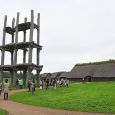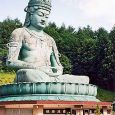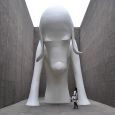Aomori
Advertisement
By air
Aomori's airport is served by Japan Airlines. JAL flights arrive from Tokyo Haneda Airport, Nagoya Centrair Airport, Osaka Itami and Kansai Airports, Sapporo Chitose Airport, and Fukuoka Airport. Buses connect the airport to the main train station for ¥560. The bus ride lasts 35 minutes.
By train
Aomori is currently the northern terminus of Japan's Shinkansen train service. From Tokyo, Tohoku Shinkansen Hayate and Hayabusa trains run to Shin-Aomori station, from which regular trains shuttle passengers over to the more centrally-located Aomori station. The trip on the Hayate takes approximately 3 hours 40 minutes, including average transfer and waiting times at Shin-Aomori, while Hayabusa trains are slightly faster. Ticketed passengers are permitted to travel to Aomori station in the non-reserved car of any train, even if a limited express train heading towards Aomori departs first.
By bus
Aomori, at the northernmost point of Honshu, is the terminating point for several highway buses.
From Tokyo Station, JR Bus Tohoku's La Foret service runs once per night, reaching Aomori in 9 1/2 hours at a cost of ¥9,000 each way on Fridays, Saturdays and the day before holidays, and ¥8,500 on all other days. Konan Bus' Tsugaru runs over the same route; their bus costs ¥7,500 each way, or ¥9,000 during peak travel periods.
By boat
Seikan Ferry and Tsugaru Kaikyo Ferry operate ferry services from Aomori to the port of Hakodate with multiple departures daily. One way fares are cheapest on the Seikan Ferry at ¥1,500 for a carpet space. The Tsugaru Kaikyo ferries are more expensive: one way fares are ¥2,700 for second class, ¥5,000 for first class and ¥6,000 for special class. Note that first and special classes are only offered on specific departures and offer better amenities, such as a room with bed. Travel time on all services is approximately 3 hours, 45 minutes.
Asamushi Aquarium
Asamushi Aquarium also called Aquarium Asamushi, is an aquarium in the Asamushi area of Aomori, Aomori Prefecture, Japan. Overlooking Mutsu Bay, it is the northernmost aquarium in Honshu. It is also the largest general aquarium in the Tohoku region. It keeps and displays 11,000 marine organisms, including those from Aomori Prefecture's abundant marine resources and over 500 species of rare aquatic animals from around the world. Its warm and cold water displays feature such marine animals as sea otters, sea lions, seals, penguins, and dolphins. The aquarium is open daily year round from 9am - 5pm .
Sannai-Maruyama
The Sannai Maruyama Archaeological Site is the largest and one of the most complete and best preserved Jomon Period (13000-300 BC) villages in Japan. Unearthed by accident while surveying land to build a community baseball field, the former Sannai Maruyama Village once included over 700 structures and dwellings including long houses, storage structures, roads, and trash and burial pits.
After the excavation and study of the site, the village was reburied with earth and a number of reconstructed pit dwellings, long houses and a large tower were built on top. Visitors can enter the reconstructions, some of which are quite large, as well as see a few of the original excavation sites around the grounds. Additionally, there is the Sannai Maruyama Exhibition Room on the site, a museum that displays pots, jewelry and tools excavated from the area.
Seiryu-ji
Seiryu-ji is a Koyasan Betsuin (an affiliate temple) located in Aomori, Aomori Prefecture. The temple was founded by a Great Acharya Ryukou Oda, who later built Showa Daibutsu in 1984. Roughly 21.35 meters in height, it is the tallest seated bronze figure of Buddha in Japan.
Aomori Museum of Art
The Aomori Museum of Art is a modern art museum found just outside of downtown Aomori City. The building houses both temporary and permanent exhibits, and was designed to resemble the Sannai Maruyama Jomon Archaeological Sites next door. Instead of being built entirely above ground, the display spaces are dug into the earth like the trenches of an archaeological excavation site, while the museum building is painted white like tents that are stretched over the trenches.
The museum's permanent collection includes three impossibly large paintings by Marc Chagall, that were originally backdrops for a ballet, which are shown in a room with 19 meter high ceilings that is sometimes used as a concert hall. Other work displayed in the permanent collection includes woodblock prints and paintings by Munakata Shiko, the pop art and almost cartoonish work of Nara Yoshitomo, as well as a huge 8.5 meter tall Aomori-Ken dog statue also by Nara.
March - July





